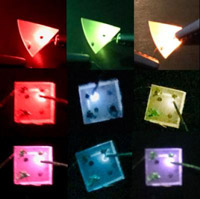- News
15 May 2019
New technique could pave way to simple color tuning of monolithically integrated GaN LEDs
A team at Lehigh University, West Chester University, Osaka University and the University of Amsterdam has demonstrated a new technique that could enable simple color tuning of gallium nitride (GaN)-based LEDs simply by changing the time sequence at which the operating current is provided to the device (ACS Photonics, ‘Color-Tunablility in GaN LEDs Based on Atomic Emission Manipulation under Current Injection’).
Notably, the technique is compatible with current LEDs that are at the core of commercial solid-state LED lighting. “This work could make it possible to tune between bright white and more comfortable warmer colors in commercial LEDs,” says Volkmar Dierolf, Distinguished Professor and Chair of Lehigh’s Department of Physics, who worked on the project.
Lead author Brandon Mitchell is a former graduate student in Dierolf's lab, now an assistant professor in the Department of Physics and Engineering at West Chester University in Pennsylvania.
In existing active LED displays, different colors are produced by three to four individual LEDs placed close to each other that create the different fundamental colors needed to produce the full color spectrum.
“We demonstrate that this can be achieved by a single LED,” says Dierolf. “We show that is possible to attain red, green and blue emissions originating from just one GaN LED structure that uses doping with a single type of rare-earth ion, europium (Eu),” he adds. “Using intentional co-doping and energy-transfer engineering, we show that all three primary colors can emit due to emission originating from two different excited states of the same trivalent Eu3+ ion (620nm red/orange and 545nm green) mixed with near-band-edge emission from GaN centered at ~430nm (blue/violet). The intensity ratios of these transitions can be controlled by choosing the current injection conditions such as injection current density and duty cycle under pulsed current injection.”
In other words, the team achieved color-tunability in a single GaN-based LED through the manipulation of the emission properties of an atomic-type dopant.
 Graphic: Top row is a GaN:Eu LED, which can be tuned from red-yellow due to red and green light mixing from different Eu states. Middle and bottom rows are of a GaN:Eu LED with additionally added Si/Mg, which adds blue emission. Each picture is under a different current injection/filtering condition. Credit: West Chester University.
Graphic: Top row is a GaN:Eu LED, which can be tuned from red-yellow due to red and green light mixing from different Eu states. Middle and bottom rows are of a GaN:Eu LED with additionally added Si/Mg, which adds blue emission. Each picture is under a different current injection/filtering condition. Credit: West Chester University.
“The main idea of this work - the simultaneous active exploitation of multiple excited states of the same dopant - is not limited to the GaN:Eu system, but is more general,” notes Mitchell. “The presented results could open up a whole new field of tunable emission of colors from a single dopant in semiconductors, which can be reached by simple injection current tuning,” he adds.
The research could benefit those looking for more comfortable ‘warmer’ white light from LEDs. “It could pave the way for monolithic integration for simple color tuning of a light bulb,” says Dierolf. “It would also be beneficial for micro-LED displays, since it allows for higher density of pixels.”
The materials used in previous research on color tunable LEDs did not allow for easy integration with current LED technology, he adds. This work is compatible with existing GaN-based LEDs that are at the core of commercial solid-state LED lighting.
https://pubs.acs.org/doi/10.1021/acsphotonics.8b01461
https://physics.cas2.lehigh.edu


